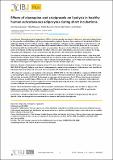Por favor, use este identificador para citar o enlazar a este item:
http://hdl.handle.net/10261/177583COMPARTIR / EXPORTAR:
 SHARE
BASE SHARE
BASE
|
|
| Visualizar otros formatos: MARC | Dublin Core | RDF | ORE | MODS | METS | DIDL | DATACITE | |

| Título: | Effects of olanzapine and aripiprazole on lipolysis in healthy human subcutaneous adipocytes during short incubations |
Autor: | Sarsenbayeva, Assel; Marques, Cátia; Boersma, Gretha; Pereira, Maria João; Eriksson, Jan W. | Palabras clave: | Adipocytes Olanzapine Aripiprazole |
Fecha de publicación: | 2018 | Citación: | IBJ Plus (S1): e0005 (2018) | Resumen: | [Introduction]: Second-generation Antipsychotics (SGAs) have become the treatment of choice over the typical antipsychotics as they provide excellent efficacy and fewer extrapyramidal symptoms. However, the compliance of the patients to SGAs is negatively affected by their ability to induce or aggravate metabolic syndrome, namely, weight gain, insulin resistance, and Type 2 Diabetes. The exact underlying mechanism of metabolic effects of SGAs is not fully elucidated and it is assumed to
be at least partially due to their effect on central nervous system. However, whether SGAs have a direct effect on insulin action in the tissues is still to be elucidated. The effect of SGAs on body metabolism varies and we have chosen two drugs, Olanzapine and Aripiprazole, which are associated with high and low risk of metabolic side-effects, respectively. Our research is focused on studying the effect of both SGAs on insulin resistance in human adipose tissue. Aside from lipid storage function, adipose tissue has been recognised, as an endocrine organ, producing hormones, such as adiponectin and leptin, indispensable for energy homeostasis. The set of experiments performed as a part of this study includes measuring the effect of Olanzapine and Aripiprazole on the lipolysis in human isolated adipocytes. [Methods]: Biopsies of subcutaneous adipose tissue (SAT) were collected from 6 patients (3 men, 3 women; age: 20-76 years; BMI: 20.9-34.5 kg/m2). Subjects were free of antidepressants or antipsychotics treatment. At the moment, only the effect of Olanzapine has been tested and measured, the experiments with Aripiprazole are in progress. A 6% adipocyte suspension was incubated with olanzapine (0.004, 0.04, 0.1, 0.2, 2 and 20 μM) or aripiprazole (0.02, 0.2, 0.5, 1, 10 and 100 μM). This was followed by 10 minutes incubation with 4 concentrations of insulin (0.1 μU; 1.0 μU; 10 μU; 100 μU) and then incubated with 0.5 μM ß-adrenergic receptor agonist, Isopretenerol, for 1h 50 min. ß-adrenergic stimulation activates hormone-sensitive lipase (HSL) enzyme via cAMP-dependent pathway. HSL, in turn, hydrolyses tritriacylglycerol (TAG), diacylglycerol (DAG) or monoacylglycerol (MAG) molecules producing free fatty acids and glycerol. The supernatant was then collected and used for glycerol measurement. [Results]: Short incubations of adipocytes with therapeutic concentrations of Olanzapine show no effect in lipolysis. The highest concentration of the drug hints at a reduced rate of lipolysis in adipocytes by more than 50% for each insulin concentration (p<0.0001) and in control conditions (p<0.01). [Conclusions]: Therefore, it seems that short-term incubation of adipocytes with 20 μM Olanzapine reduces the rate of lipolysis, while the therapeutic concentrations do not seem to alter lipolysis in adipocytes. |
Descripción: | Resumen del trabajo presentado al 5th Symposium on Biomedical Research: "Advances and Perspectives In Pharmacology, Drug Toxicity and Pharmacogenetics", celebrado en Madrid del 15 al 16 de marzo de 2018. | Versión del editor: | https://doi.org/10.24217/2531- 0151.18v1s1.00005 | URI: | http://hdl.handle.net/10261/177583 | DOI: | 10.24217/2531- 0151.18v1s1.00005 | ISSN: | 2531-0151 |
| Aparece en las colecciones: | (IIBM) Artículos |
Ficheros en este ítem:
| Fichero | Descripción | Tamaño | Formato | |
|---|---|---|---|---|
| effeincuba.pdf | 646,32 kB | Adobe PDF |  Visualizar/Abrir |
CORE Recommender
Page view(s)
295
checked on 09-may-2024
Download(s)
146
checked on 09-may-2024
Google ScholarTM
Check
Altmetric
Altmetric
Este item está licenciado bajo una Licencia Creative Commons

